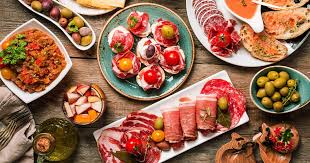Spain Beyond Tapas: Exploring Regional Cuisines

When Spain appears in food discussions, tapas dominate the image: small plates, shared tables, and long conversations. This idea is familiar, but it tells only part of the story. Spanish cooking is not one uniform tradition but a map of many local ones. From the Atlantic coast to the Mediterranean, each region has its own way of cooking, eating, and defining hospitality. To understand this diversity is to understand how Spanish food reflects its landscapes and its people. And, just as in games of skill and chance — such as thimbles casino — the joy often lies in paying attention to the details that seem small but shape the whole experience.
The North: A Culture Tied to Water and Weather
In Galicia, food begins with the sea. Fishermen bring in octopus, clams, and mussels that find their way into local markets every morning. The cooking style is restrained: boiling, grilling, a touch of olive oil. The point is not invention but respect for the raw material. In this region, geography dictates taste — cool waters and heavy rain make seafood central, while dairy and potatoes fill the inland diet.
Moving east, the Basque Country turns cooking into both craft and identity. The Basque people use food as a language of belonging. Simple dishes like bacalao al pil-pil rely on timing and touch rather than elaborate recipes. The Basque coastline provides fish; the hills supply cider and vegetables. Over the past few decades, Basque chefs have led Spain’s modern culinary reputation, but the foundation remains local and personal.
Catalonia and Valencia: Balancing Land and Sea
Catalonia blends Mediterranean ingredients with mountain traditions. The cuisine shows how geography compresses contrasts into a single region. A stew like escudella i carn d’olla reflects inland life, while suquet de peix brings the sea to the table. Sauces like romesco, made from almonds and peppers, connect these two worlds. Catalan cooks often talk about harmony rather than technique — an idea that shapes both home cooking and restaurant food.
Valencia tells another story of adaptation. Its wetlands near Albufera made rice farming central, giving rise to paella. The dish is not a single recipe but a reflection of place: rabbit and beans inland, seafood on the coast. The rhythm of rice cultivation set the pace of local eating habits. Beyond paella, citrus fruits and almonds define everyday dishes, linking agriculture with flavor.
The Central Plains: Simple Food, Strong Traditions
In Castile and La Mancha, open land and harsh weather influence everything on the table. Meals here rely on wheat, olive oil, and sheep’s milk. Roasted meats — lamb, suckling pig — are cooked in clay ovens that have changed little in centuries. These foods suit a life once tied to farming and herding, built around endurance more than variety.
La Mancha, famous through Cervantes, carries a sense of frugality and ingenuity. Gachas manchegas, made from flour and pork fat, appears modest, but it embodies a way of making do with what the land gives. Saffron, one of the region’s few luxuries, adds both color and income to the local economy. Castilian cooking may seem austere, but it expresses a deeper value: continuity.
The South: Echoes of History
Andalusia shows how history shapes taste. For centuries, this region absorbed influences from North Africa and the Mediterranean. Ingredients like almonds, honey, and spices reveal that legacy. Gazpacho and salmorejo use local tomatoes and olive oil to fight the summer heat, while pescaito frito fills beachside bars. The balance of sweet and savory in dishes like berenjenas con miel shows how cultures met and left their marks.
Food in Andalusia also carries memory. Olive oil, a defining product, connects modern agriculture with ancient trade routes. Local recipes change from coast to mountain, but the use of oil, bread, and vinegar ties them together. Here, cuisine functions as a form of continuity, preserving fragments of the past through everyday meals.
The Islands: Resourceful and Distinct
Spain’s island regions — the Balearics in the Mediterranean and the Canaries off Africa — developed independently. Isolation produced creative adaptations. The Balearic Islands make sobrasada, a cured sausage flavored with paprika, and ensaimada, a spiral pastry eaten at festivals. Both emerged from limited local ingredients and a need for preservation.
The Canary Islands, shaped by volcanic soil and trade with the Americas, use local peppers, bananas, and tropical fruits in simple combinations. Mojo picón, a pepper-based sauce, appears with fish, potatoes, or bread. These island cuisines, less known abroad, show how Spanish food continues to evolve on the edges of its geography.
A Pattern of Difference
Regional cooking in Spain is not a collection of recipes but a network of small systems built over time. Climate determines crops, trade routes bring ingredients, and local habits decide what becomes tradition. Tapas represent a social idea — sharing, conversation, leisure — but the deeper structure of Spanish food lies in how each region solves the question of survival and taste.
Exploring Spain beyond tapas means seeing food as a form of geography. Each dish is a record of adaptation: people adjusting to land, water, and history. The diversity of Spanish cuisine is less about novelty than about persistence — a quiet dialogue between the past and the present, carried on through the act of cooking and eating.




